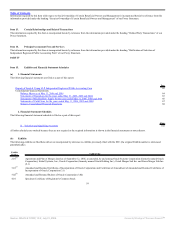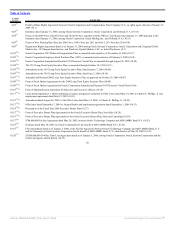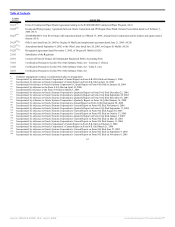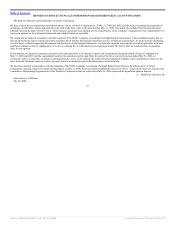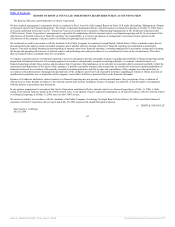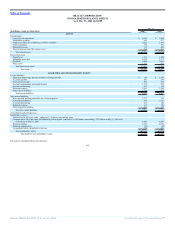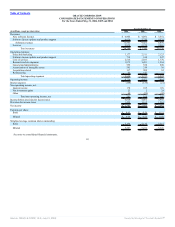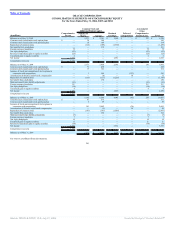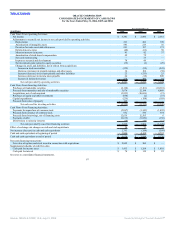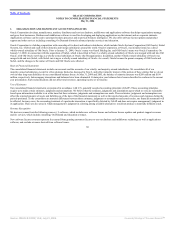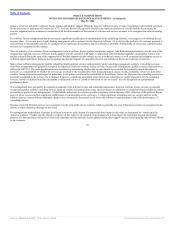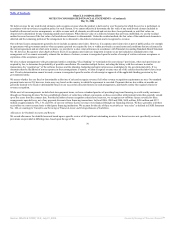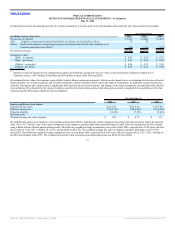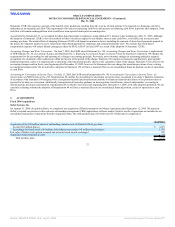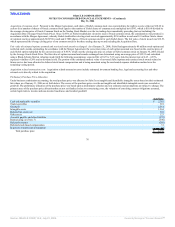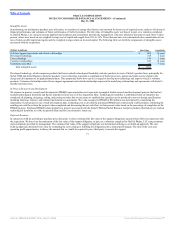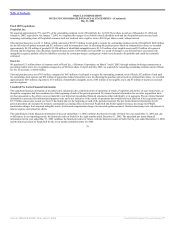Oracle 2005 Annual Report Download - page 72
Download and view the complete annual report
Please find page 72 of the 2005 Oracle annual report below. You can navigate through the pages in the report by either clicking on the pages listed below, or by using the keyword search tool below to find specific information within the annual report.
Table of Contents
ORACLE CORPORATION
NOTES TO CONSOLIDATED FINANCIAL STATEMENTS—(Continued)
May 31, 2006
updates, which are included in software license updates and product support. While the basis for software license revenue recognition is substantially governed
by the provisions of Statement of Position No. 97-2, Software Revenue Recognition, issued by the American Institute of Certified Public Accountants, we
exercise judgment and use estimates in connection with the determination of the amount of software and services revenues to be recognized in each accounting
period.
For software license arrangements that do not require significant modification or customization of the underlying software, we recognize new software license
revenue when: (1) we enter into a legally binding arrangement with a customer for the license of software; (2) we deliver the products; (3) customer payment is
deemed fixed or determinable and free of contingencies or significant uncertainties; and (4) collection is probable. Substantially all of our new software license
revenues are recognized in this manner.
The vast majority of our software license arrangements include software license updates and product support, which are recognized ratably over the term of the
arrangement, typically one year. Software license updates provide customers with rights to unspecified software product upgrades, maintenance releases and
patches released during the term of the support period. Product support includes internet access to technical content, as well as internet and telephone access to
technical support personnel. Software license updates and product support are generally priced as a percentage of the net new software license fees.
Many of our software arrangements include consulting implementation services sold separately under consulting engagement contracts. Consulting revenues
from these arrangements are generally accounted for separately from new software license revenues because the arrangements qualify as service transactions as
defined in SOP 97-2. The more significant factors considered in determining whether the revenue should be accounted for separately include the nature of
services (i.e., consideration of whether the services are essential to the functionality of the licensed product), degree of risk, availability of services from other
vendors, timing of payments and impact of milestones or acceptance criteria on the realizability of the software license fee. Revenues for consulting services are
generally recognized as the services are performed. If there is a significant uncertainty about the project completion or receipt of payment for the consulting
services, revenue is deferred until the uncertainty is sufficiently resolved. Contracts with fixed or “not to exceed” fees are recognized on a proportional
performance basis.
If an arrangement does not qualify for separate accounting of the software license and consulting transactions, then new software license revenue is generally
recognized together with the consulting services based on contract accounting using either the percentage-of-completion or completed-contract method. Contract
accounting is applied to any arrangements: (1) that include milestones or customer specific acceptance criteria that may affect collection of the software license
fees; (2) where services include significant modification or customization of the software; (3) where significant consulting services are provided for in the
software license contract without additional charge or are substantially discounted; or (4) where the software license payment is tied to the performance of
consulting services.
Revenues from On Demand services are recognized over the term of the service contract, which is generally one year. Education revenues are recognized as the
classes or other education offerings are delivered.
For arrangements with multiple elements, we allocate revenue to each element of a transaction based upon its fair value as determined by “vendor specific
objective evidence.” Vendor specific objective evidence of fair value for all elements of an arrangement is based upon the normal pricing and discounting
practices for those products and services when sold separately and for software license updates and product support services based upon the renewal rate offered
to the customer.
69
Source: ORACLE CORP, 10-K, July 21, 2006 Powered by Morningstar® Document Research℠


